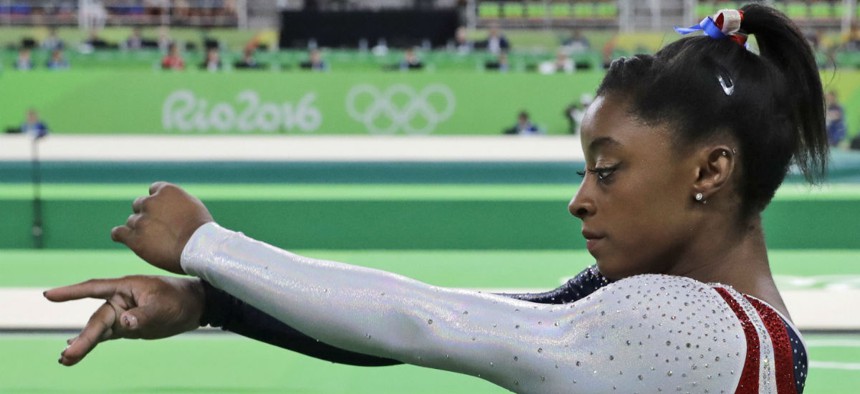
Simone Biles prepares for the women's team final at the 2016 Summer Olympics in Rio de Janeiro on Aug. 9. AP Photo/Charlie Riedel
How to Prepare for Your Meetings Like Olympians Prepare to Compete
I’ve been teaching leaders how to use this visualization technique in peer or self-coaching scenarios for years now and the hit rate is around 100 percent.
Last night, Diane and I were watching the U.S. women’s gymnastics team compete in the opening round of competition in the Rio Olympics. The floor exercises were the most astounding thing I saw. Tiny young women like Simone Biles, Laura Hernandez, and Aly Raisman stand at one corner of a springy floor, gather themselves, seemingly go from zero to 60 in about half a second and then launch themselves 8 or 9 feet in the air to do a couple of flips while they lay their bodies out flat in the air, rotate themselves on another plane, land solidly on their feet and immediately start another move that’s even more amazing.
One of the things I love about watching the Olympics is when the camera zooms in on the face of the athletes right before they compete. They all do the same thing. Their eyes appear to fix on a point that only they can see. They take a deep breath and then they go. With the women gymnasts you can see them holding the fixed gaze and taking the breath in the middle of their routines as they start another run that launches them into more flips across the floor.
Of course, it’s not just the gymnasts who have this routine of gazing and breathing. All of the best athletes do something similar whether it’s the swimmers, the runners or the volleyball players. You know what they’re doing — they’re visualizing. Earlier this year in a leadership development program I was running, a three-time Hungarian Olympian swimmer named Tamas Kerekjarto confirmed for me what’s going through the athlete’s mind in those last moments. It’s two questions:
- What am I trying to do?
- How do I need to perform to do that?
I’ve been sharing those two questions with leaders for years now because they have application far beyond the Olympics. Think about it. How often do you show up for your fifth or sixth meeting of the day without a clue about what you want to accomplish in that conversation and how you need to show up to do that? If you’re like a lot of the leaders I work with, the answer is pretty often and the results aren’t so great.
Here’s the thing. It doesn’t take a lot of time or even that much mental effort to dramatically improve your performance in a meeting or a conversation.
Try it today. Before your next meeting or conversation begins, take two minutes to visualize. Here’s how to do it.
- Take three deep breaths from your belly. That will activate your parasympathetic nervous system and help you clear the mental clutter that accumulated in your last conversation.
- Ask yourself, “If I’m completely successful in this next meeting, what happens at the end?” What do people know, think, do, feel or believe as a result of the conversation we’ve had?” Give yourself space to imagine who’s going to be in the room and the ideal mental and emotional state you’d like them to be in at the end of the meeting.
- Then ask yourself, “How do I need to show up to make that outcome likely?” What kind of energy are you bringing to the meeting? Is it high positive (e.g., enthusiastic) energy, low positive (e.g., calm) energy, high negative (e.g., frustrated) energy, or low negative (e.g., disappointed) energy? Are you starting the meeting with one kind of energy and then shifting to another? What’s your tone of voice sound like? What are you projecting with your body language? What impact do you want your energy to have on the other people in the meeting? How do you want them to feel and how does that feeling support the result you’re trying to create?
I’ve been teaching leaders how to use this visualization technique in peer or self-coaching scenarios for years now and the hit rate is around 100 percent. Leaders almost always report a much greater sense of confidence about what they’re trying to do in the meeting and how they need to show up to do that. When they report back to me how things played out in real life, they often tell me how much better things went after a couple of minutes of pre-meeting visualization.
Taking a couple of minutes to visualize what you need to do and how you need to do it is relatively easy to do and almost always makes a difference. And the even better news is that you don’t have to spend years training like Simone Biles or Michael Phelps for it to work.
NEXT STORY: Ebook: Raising the Bar for Management







